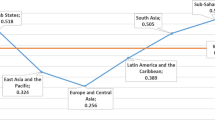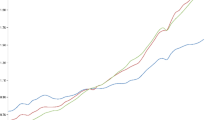Abstract
The sustainable development goals (SDGs) provide an integrated, evidence-based framework of targets and indicators to support national planning and reporting. For countries to begin implementation of the SDGs, it is critical to build the evidence base for action. The integrated nature of the SDG targets mean that progress towards one target is also linked through complex feedbacks to other targets, placing demands on science and research to support national implementation. A range of different tools and approaches are recommended by experts, and an emerging challenge is to coherently apply and combine these different approaches to support decision-making. This study makes a significant contribution to filling this knowledge gap, adopting a novel integrated assessment approach to support the prioritisation of SDG targets through a case study for 22 countries in the Arab region. The research adopts a multi-criteria analysis decision framework which assesses and prioritises SDG targets based upon their ‘level of urgency’, ‘systemic impact’, and ‘policy gap’. A range of complementary evidence- and science-based approaches are applied within the assessment framework, including baseline assessment and benchmarking of indicators, systems and network analysis of target interlinkages, and mapping of policy alignment and gaps. The study highlights the strengths and weaknesses of each of these analytical approaches, and demonstrates how they can be rapidly combined and applied.



Similar content being viewed by others
Notes
A total of 66 countries submitted VNRs in 2016 and 2017.
Doha Declaration on Implementation of the 2030 Agenda, 29th UNESCWA Ministerial Session in 2016.
Preparatory Meeting on the Regional Environmental Issues and Priorities for the Arab Forum on Sustainable Development held in Cairo on 23–24 April 2017.
Consultative Meeting on the Implementation Framework for the Environmental Dimension of the 2030 Agenda in the Arab Region held in Cairo from 18 to 21 September 2017.
Note that step 6 in Fig. 1 did not form part of the technical MCA assessment and is not discussed in this paper.
For example, United Nations Environment Programme 2016a. GEO-6 Regional Assessment for Africa, Nairobi, Kenya, United Nations Environment Programme 2016b. GEO-6 REgional Assessment for West Asia, Nairobi, Kenya., United Nations Economic and Social Commission for Western Asia, United Nations Environment Programme 2015. Arab Sustainable Development Report, Beirut; and regional environmental reports published by the Arab Forum for Environment and Development (AFED): http://www.afedonline.org/en/inner.aspx?contentID=1238.
This included the Arab Strategic Framework for Sustainable Development (ASFSD), the Arab Sustainable Development Indicators framework, and a range of other regional environmental strategies adopted by LAS relating to water, energy, sustainable production and consumption, agriculture, disasters, climate change, amongst others.
The Arab Working Group on Sustainable Development Indicators has defined a set of 30 priority environmental SDG indicators.
Tier I = clear method and regularly produced; Tier II = clear method but data not regularly produced; Tier III = no method.
Eight indicators were duplicates and thus the total number of different indicators was 49.
Consultative Meeting on the Implementation Framework for the Environmental Dimension of the 2030 Agenda in the Arab Region held in Cairo from 18 to 21 September 2017.
Including the UN SDG database https://unstats.un.org/sdgs/indicators/database/; World Bank database: http://databank.worldbank.org/data/home.aspx.
Gulf Cooperation Council (GCC): Bahrain, Kuwait, Oman, Qatar, Saudi Arabia and the United Arab Emirates; Least Developed Countries (LDCs): the Comoros, Djibouti, Mauritania, Somalia, the Sudan and Yemen; Maghreb: Algeria, Libya, Morocco and Tunisia; and Mashreq: Egypt, Iraq, Jordan, Lebanon, Palestine and the Syrian Arab Republic.
Consultative Meeting on the Implementation Framework for the Environmental Dimension of the 2030 Agenda in the Arab Region held in Cairo from 18 to 21 September 2017.
The software used was the cloud-based network analysis software Kumu: https://kumu.io/.
193 positive interactions versus 23 negative interactions.
Jordan, United Arab Emirates (UAE), Egypt and Somalia. These countries were selected to cover different Arab sub-regions and because they had recently undertaken a Voluntary National Review, or adopted a national vision or development strategy that considered the SDGs (and was available in English).
References
Agryzkov T, Oliver JL, Tortosa L, Vicent J (2014) A new betweenness centrality measure based on an algorithm for ranking the nodes of a network. Appl Math Comput 244:467–478
Allen C, Metternicht G, Wiedmann T (2016) National pathways to the Sustainable Development Goals (SDGs): a comparative review of scenario modelling tools. Environ Sci Policy 66:199–207
Allen C, Metternicht G, Wiedmann T (2017a) An iterative framework for national scenario modelling for the sustainable development goals (SDGs). Sustain Dev 25:372–385
Allen C, Nejdawi R, El-Baba J, Hamati K, Metternicht G, Wiedmann T (2017b) Indicator-based assessments of progress towards the sustainable development goals (SDGs): a case study from the Arab region. Sustain Sci 12:975–989
Allen C, Metternicht G, Wiedmann T (2018) Initial progress in implementing the sustainable development goals (SDGs)—a review of evidence from countries. Sustain Sci. https://doi.org/10.1007/s11625-018-0572-3
Borgatti SP (2005) Centrality and network flow. Soc Netw 27:55–71
Campagnolo L, Carraro C, Eboli F, Farnia LL (2016) Assessing SDGs: a new methodology to measure sustainability
Collste D, Pedercini M, Cornell SE (2017) Policy coherence to achieve the SDGs: using integrated simulation models to assess effective policies. Sustain Sci 1–11
Coopman A, Osborn D, Ullah F, Auckland E, Long G (2016) Seeing the Whole: implementing the sdgs in an Integrated and Coherent Way, Research Pilot Report. Stakeholder Forum for a Sustainable Future
Costanza R, Daly L, Fioramonti L, Giovannini E, Kubiszewski I, Mortensen LF, Pickett KE, Ragnarsdottir KV, De Vogli R, Wilkinson R (2016) Modelling and measuring sustainable wellbeing in connection with the UN sustainable development goals. Ecol Econ 130:350–355
Cutter A, Osborn D, Romano J, Ullah F (2015) Sustainable development goals and integration: achieving a better balance between the economic, social and environmental dimensions. Stakeholder Forum. German Council for Sustainable Development
Eurostat (2017) Sustainable development in the European Union: monitoring report on progress towards the SDGs in an EU context, Luxembourg
Freeman LC (1978) Centrality in social networks conceptual clarification. Soc Netw 1:215–239
Institute for Global Environmental Strategies (2017) Sustainable Development goals interlinkages and network analysis: a practical tool for SDG integration and policy coherence, Japan
International Council for Science (2017) A guide to SDG interactions: from science to implementation
Jayaraman R, Colapinto C, La Torre D, Malik T (2015) Multi-criteria model for sustainable development using goal programming applied to the United Arab Emirates. Energy Policy 87:447–454
Kroll C (2015) Sustainable development goals: are the rich countries ready. Bertelsmann Stiftung, Guetersloh
Le Blanc D (2015) Towards integration at last? the sustainable development goals as a network of targets. Sustain Dev 23:176–187
Nilsson M, Griggs D, Visbeck M (2016a) Map the interactions between sustainable development goals. Nature 534:320–322
Nilsson M, Griggs D, Visbeck M, Ringler C (2016b) A draft framework for understanding SDG interactions
Organisation for Economic Cooperation and Development (2016) Measuring distance to the SDGs Targets: a pilot assessment of where OECD countries stand. Organisation for Economic Cooperation and Development, Paris
Reyers B, Stafford-Smith M, Erb K-H, Scholes RJ, Selomane O (2017) Essential variables help to focus sustainable development goals monitoring. Curr Opin Environ Sustain 26:97–105
Saito O, Managi S, Kanie N, Kauffman J, Takeuchi K (2017) Sustainability science and implementing the sustainable development goals. Sustain Sci 12:907–910
Schmalzbauer B, Visbeck M (2016) The contribution of science in implementing the sustainable development goals. German Committee Future Earth, Stuttgart/Kiel. ISBN 978-3-9813068-5-9 PDF-Document
Schmidt-Traub G, Kroll C, Teksoz K, Durand-Delacre D, Sachs JD (2017) National baselines for the sustainable development goals assessed in the SDG Index and Dashboards. Nat Geosci 10:547–555
Steele K, Carmel Y, Cross J, Wilcox C (2009) Uses and misuses of multicriteria decision analysis (MCDA) in environmental decision making. Risk Anal 29:26–33
Sustainable Development Solutions Network (2015) Getting started with the sustainable development goals: a guide for stakeholders, New York
United Nations Development Group (2017) Mainstreaming the 2030 Agenda: reference guide for UN Country Teams, New York
United Nations Economic and Social Commission for Asia and the Pacific (2016) Analytical framework for integration of water and sanitation SDGs and targets using a systems thinking approach: working paper, Bangkok
United Nations Economic and Social Commission for Western Asia (2016) Doha declaration on implementation of the 2030 Agenda. United Nations Economic and Social Commission for Western Asia, Beirut
United Nations Economic and Social Commission for Western Asia, United Nations Environment Programme (2015) Arab Sustainable Development Report, Beirut
United Nations Environment Programme, Food and Agriculture Organisation of the United Nations (2015) Marine Resources in the Arab Region, Issues Brief for the Arab Sustainable Development Report. UNESCWA, Beirut, Lebanon
United Nations Environment Programme (2016a) GEO-6 Regional Assessment for Africa. Nairobi, Kenya
United Nations Environment Programme (2016b) GEO-6 Regional Assessment for West Asia, Nairobi, Kenya
United Nations General Assembly (2015) Transforming our world: the 2030 Agenda for Sustainable Development, outcome document of the United Nations summit for the adoption of the post-2015 agenda, RES/A/70/L.1. United Nations
United Nations Institute for Training and Research, 2016. Preparing for Action—The 2030 Agenda for Sustainable Development: Learning Manual
Weitz N, Carlsen H, Nilsson M, Skånberg K (2017) Towards systemic and contextual priority setting for implementing the 2030 Agenda. Sustain Sci 1–18
Acknowledgements
The authors would like to acknowledge the contribution of Ms Reem Nejdawi and Ms Lara Geadah of UNESCWA, who provided project oversight and feedback throughout the assessment process. The funding from UNESCWA to undertake the study is also acknowledged. We would also like to thank the many experts and practitioners from the Arab region who participated in the formal and informal consultations that supported the assessment.
Author information
Authors and Affiliations
Corresponding author
Additional information
Handled by Jeremy Brooks, Ohio State University School of Environment and Natural Resources, United States.
Electronic supplementary material
Below is the link to the electronic supplementary material.
Rights and permissions
About this article
Cite this article
Allen, C., Metternicht, G. & Wiedmann, T. Prioritising SDG targets: assessing baselines, gaps and interlinkages. Sustain Sci 14, 421–438 (2019). https://doi.org/10.1007/s11625-018-0596-8
Received:
Accepted:
Published:
Issue Date:
DOI: https://doi.org/10.1007/s11625-018-0596-8




